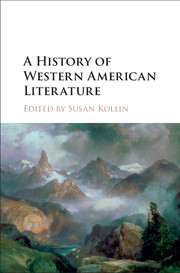Book contents
- Frontmatter
- Contents
- Notes on Contributors
- Acknowledgments
- Introduction: Historicizing the American Literary West
- PART I HOMELANDS
- PART II MAKING A REGION
- PART III GEOGRAPHIES OF THE LITERARY WEST
- PART IV THE TWENTIETH CENTURY AND BEYOND: LITERARY MOVEMENTS AND CRITICAL PERSPECTIVES
- 14 Early Cinematic Westerns
- 15 The Environmental Novel of the American West
- 16 Hard-Boiled Fiction and Noir Narratives
- 17 The Beats and the American West
- 18 Contested Wests: Indigenous Americans and the Literature of Sovereignty
- 19 Asian American Writers and the Making of the Western U.S. Landscape
- 20 African American Literature: Recasting Region through Race
- 21 Hollywood Westerns: 1930s to the Present
- 22 Urban New Wests
- 23 Queer Frontiers: Gender and Sexuality in the American West
- 24 Postwestern Literature and Criticism
- Selected Bibliography
- Index
18 - Contested Wests: Indigenous Americans and the Literature of Sovereignty
from PART IV - THE TWENTIETH CENTURY AND BEYOND: LITERARY MOVEMENTS AND CRITICAL PERSPECTIVES
Published online by Cambridge University Press: 05 November 2015
- Frontmatter
- Contents
- Notes on Contributors
- Acknowledgments
- Introduction: Historicizing the American Literary West
- PART I HOMELANDS
- PART II MAKING A REGION
- PART III GEOGRAPHIES OF THE LITERARY WEST
- PART IV THE TWENTIETH CENTURY AND BEYOND: LITERARY MOVEMENTS AND CRITICAL PERSPECTIVES
- 14 Early Cinematic Westerns
- 15 The Environmental Novel of the American West
- 16 Hard-Boiled Fiction and Noir Narratives
- 17 The Beats and the American West
- 18 Contested Wests: Indigenous Americans and the Literature of Sovereignty
- 19 Asian American Writers and the Making of the Western U.S. Landscape
- 20 African American Literature: Recasting Region through Race
- 21 Hollywood Westerns: 1930s to the Present
- 22 Urban New Wests
- 23 Queer Frontiers: Gender and Sexuality in the American West
- 24 Postwestern Literature and Criticism
- Selected Bibliography
- Index
Summary
In 1830 President Andrew Jackson signed into the law the Indian Relocation Act, “to provide for an exchange of lands with the Indians residing in any of the states or territories, and for their removal west of the river Mississippi.” The ever-shifting American West has been Indian Country within the settler psyche ever since. Native people dwell in the spaces west of the national collective self; as such, it seems natural to speak of the land as a contested space of sovereignty when viewed from an Indigenous perspective. Yet what any settler colonial nation believes about the Indigenous people and peoples of the land it occupies – as well as how it defines them legally – should always be viewed skeptically. The United States’ construction of the West as Indian Country has always served to justify its presence on the lands it paints to be its overt birthright. The lands of the American West had to be conquered by the denizens of the settled and civilized East Coast. The story of the conquest of those eastern lands thus is written out of the national history (“that was the doing of the French and British”) or whitewashed as some happy cooperation (see Thanksgiving).
Just as Native people have been placed in the American West by the settler imaginary, they have also been relegated to the past. Whether temporally or physically, they are, in all cases, “over there,” just over the (event) horizon, never “here.” American Indians thus represent a spectral distance in time and space. Settler colonialism operates under what Patrick Wolfe calls the “logic of elimination,” which “not only refers to the summary liquidation of Indigenous people, though it includes that,” but also to the delegitimizing of Indigenous claims to place and identity. Accordingly, the settler state asserts that all the real Indians are dead; what remain are withered relics or inauthentic, assimilated tragedies. Native American people, and with them, Native American Studies, must correct these imposed temporal distances. Native artists have developed a number of strategies for dealing with them, with many opting to draw links between past and present in their work, and to rectify literary history in the process.
- Type
- Chapter
- Information
- A History of Western American Literature , pp. 282 - 297Publisher: Cambridge University PressPrint publication year: 2015

